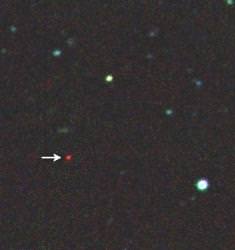An international team of astronomers have discovered a supermassive black hole at the very edge of the observable Universe, located 13 billion light-years away. Since the Universe is 13.7 billion years old, we’re seeing this object when the Universe was only 700 million years old. Wow.
Active galactic nuclei, or quasars, occur when a supermassive black hole is feasting on infalling material. Material piles up faster than the black hole can feed, and it starts to glow so brightly that astronomers can see it clear across the Universe. This object, CFHQS J2329-0301, was discovered as part of a new distant quasar survey performed with the MegaCam imager on the Canada-France-Hawaii Telescope (CFHT).
The black hole powering the quasar is thought to have 500 million times the mass of the Sun – that makes it hungry and bright. And because the quasar is so bright, astronomers can use it as a background object to examine the gas in front. And with follow up observations, they can get more details about what kind of galaxy it formed inside.
Original Source: Canada-France-Hawaii Telescope News Release

